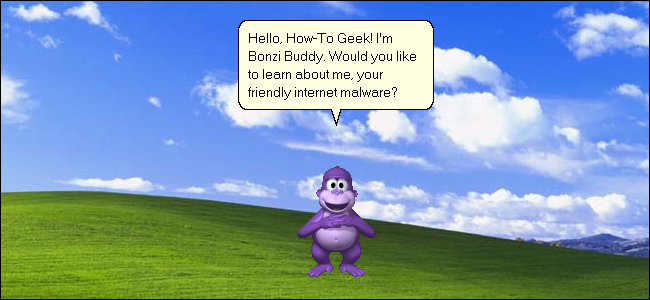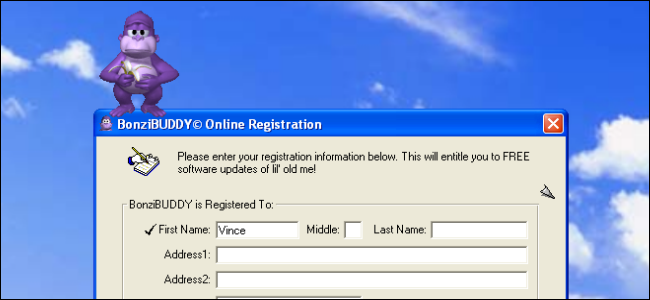If you had a computer in the early 2000s and didn't have a ton of common sense (or proper antivirus software), you probably ended up with an allegedly helpful purple ape named BonziBuddy crowding your desktop. He could talk, tell jokes, "sing," and generally annoy you. He promised to help you use the internet, but mostly he just got in the way.
If you aren't familiar with BonziBuddy, that probably sounds pretty weird to you...but the backstory behind this weird relic of the aughts is even stranger than the monkey himself.
Where Do Purple Monkeys Come From?
In today's world, virtual assistants seem normal. Alexa, Siri, Google, and even Cortana are household names, and we just sort of accepted the idea that a disembodied, vaguely human-sounding voice can help us do routine tasks. That much at least makes some sense to us now, but who in their right mind would think that you'd want a purple cartoon monkey to help you use the internet in 1999?
To answer that question, we have to go back to find another familiar face from the past: Clippy. As part of the Office 97 release, Microsoft introduced Office Assistant, an animated character that would pop up to help you do things as you worked. The default skin for Office Assistant was Clippit (commonly shortened to Clippy), a paper clip with googly eyes and a penchant for bothering you as soon as you started working on a document.
Microsoft designed this assistant feature after "tragically misunderstanding" a Stanford University study that observed humans emotionally respond to computers the same way they respond to people. In Microsoft's collective mind, this meant they should start putting faces and voices on their screens, so people would enjoy using their computer more. It didn't exactly work.
Clippy was built on a technology called Microsoft Agent. Agent itself was derived from code that was first introduced in Microsoft Bob (to give you an idea of how deep this bad idea rabbit hole goes). Microsoft Agent allowed third-party developers to add their own assistants to their applications. These assistants could talk, answer voice commands, and perform actions on a user's behalf. The company even created four default characters that developers could choose from: Merlin the Wizard, Robby the Robot, Genie the Genie, and Peedy the Parrot. The Microsoft Office team decided to make their own character when they created Clippy, rather than use one of the defaults. Microsoft also created a separate character based on the help icon to walk you through Windows XP's installation process.
While Microsoft never used any of its generic characters internally, Peedy the Parrot would find a home outside the company. Third-party developer BONZI Software used Peedy as the first version of its standalone helper program "BonziBUDDY." Microsoft had intended these assistants to be bundled with other programs, but Bonzi's assistant was designed to help with everything. It would sit on your desktop all the time, talk to you every once in a while, and you could ask it to do things like...well, frankly, it wasn't that useful, but it sure was fun to hear it talk.
After a couple iterations of the program, Bonzi decided that they didn't want to just use the generic character that anyone could use. The company created their own cartoon character that was somehow sillier than a talking green parrot: a talking purple monkey. While any developer could include Peedy in their programs, only Bonzi had their trademark monkey. Looking back, sure it didn't make much sense to create a purple ape assistant from whole cloth, but perhaps Bonzi's biggest sin (so far in the story, anyway), was reskinning Microsoft's bad decisions.
Bonzi, Tell Me a Joke
BonziBuddy may have essentially been a worse version of Clippy, but it had one thing going for it that Clippy didn't have: It wasn't tied to office software. Or any application for that matter. This meant that anyone from eight year olds to their grandmothers could download the "cute purple monkey" and play with it just for fun. BonziBuddy was free, so there seemed to be no harm in downloading it. This is also how many young people learned not to download things just because they're free.
Bonzi's speech engine (part of the Microsoft Agent suite), was a huge novelty around the time it was released in 1999. While speech synthesizers existed well before that, most people didn't have a user-friendly way to play with them. Bonzi would occasionally speak up to share a lame joke or sing a song in a nauseatingly robotic voice, but he talked funny. You could also make Bonzi say whatever you wanted with it's text-to-speech feature. Anyone who watched a Flash animation in the early aughts knows how much fun you can have with an early speech synthesizer you control.
Beyond the novelty, Bonzi claimed to offer more practical features. You could use the built-in calendar to keep track of your events. You could sync your POP3 email so Bonzi could read off your messages to you. That...was about it. You could open a box to enter a search term or web site address and Bonzi would pass it off to your browser, but that's even more complicated than just opening your browser directly. Ultimately, BonziBuddy was more useful as a toy than a real productivity program. Bonzi also has had a nasty habit of randomly swinging on a green vine from one side of your computer to another, which got in the way of whatever you were doing. Bonzi was a showman and he would not be upstaged by your spreadsheets.
BonziBuddy would also promote Bonzi Software's other programs, often using deceptive popups that looked like official Windows alerts. These included Bonzi Software's original software hit, a voice email app. This app let you record audio and attach a picture to email. No, it wasn't any more revolutionary in the 90s than it sounds now, but it was mildly successful for the company. They also offered Internet Alert 99, which was a glorified firewall, and Internet Boost, which claimed to increase your internet speed by tweaking "various configuration parameters used by the Microsoft TCP/IP stack." This claim was dubious at best. It was also the start of BonziBuddy's descent into earning the malware label it has today.
The People vs. BonziBuddy
Bonzi Software, the company behind your buddy, faced a few separate legal issues in the time from 1999 to 2004, when BonziBuddy was finally discontinued. In 2002, the company was hit with a class action lawsuit over its use of deceptive ads. When they settled in 2003, Bonzi agreed to stop employing fake "X" buttons that didn't actually close the ad, and was forced to clearly label their popups as ads. They also had to pay over $170,000 in legal fees.
Separately in 2004, Bonzi Software was forced to pay a $75,000 fine to the FTC for violation of the Children's Online Privacy Protection Act. Whenever BonziBuddy launched, it prompted users to register online (as pretty much every application did in those days). On this registration form, BonziBuddy asked for the name, address, and ages of its users. Since a cartoon ape was appealing to kids, children would sometimes download the app and, not knowing any better, fill out the registration form. This led to Bonzi collecting personal information about children without parental consent.
On top of the legal problems, BonziBuddy grew more irksome in an attempt to monetize their userbase. In later years of its existence, BonziBuddy would install toolbars in Internet Explorer, reset your browser's home page to Bonzi.com, and even track statistics about your internet usage. Whether Bonzi meant to employ scummy malware tactics from the start or if they just got desperate from financial troubles, the result was the same. BonziBuddy wasn't here to tell you jokes and sing songs anymore. It was here to screw up your computer and serve you ads.
In retrospect, while BonziBuddy may have been a terrible application, it had its charm. His dumb jokes, his ridiculous voice, and his over the top animations were annoying when you couldn't get rid of them, but at least they gave him some personality. That's more than you can say for most things that serve you popup ads or install toolbars on your machine.
If you feel like playing with your old monkey friend again, fans of BonziBuddy have created mirrors of the original Bonzi site, as well as download links to get Bonzi on your computer. Since the servers that ran ads and tracked data have long since been shut off, BonziBuddy shouldn't be much of a threat anymore. However, we still recommend using a virtual machine to keep him contained if you really think that intentionally downloading animated malware is a good use of your time.



